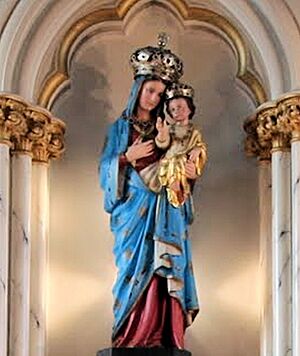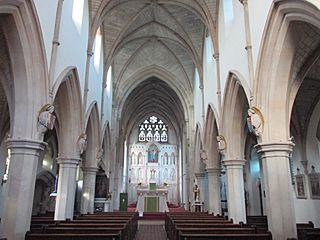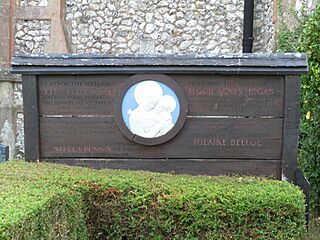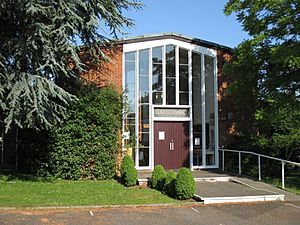Shrine of Our Lady of Consolation facts for kids
Quick facts for kids Shrine of Our Lady of Consolation |
|
|---|---|
| Shrine and Parish Church of Our Lady of Consolation and Saint Francis | |
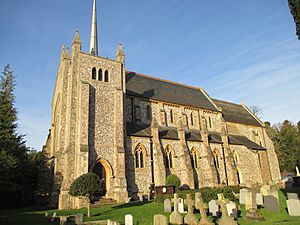 |
|
| Lua error in Module:Location_map at line 420: attempt to index field 'wikibase' (a nil value). | |
| OS grid reference | TQ 17709 21153 |
| Location | West Grinstead, West Sussex |
| Country | England |
| Denomination | Roman Catholic |
| Website | Consolation.org.uk |
| History | |
| Status | Active |
| Founder(s) | Fr Jean-Marie Denis |
| Dedication | Blessed Virgin Mary Saint Francis of Assisi |
| Relics held | Blessed Francis Bell |
| Architecture | |
| Functional status | Parish church |
| Heritage designation | Grade II listed |
| Designated | 22 February 2007 |
| Architect(s) | John Crawley (architect) |
| Style | Gothic Revival |
| Groundbreaking | 29 May 1875 |
| Completed | 27 June 1876 |
| Administration | |
| Deanery | Crawley |
| Diocese | Arundel and Brighton |
| Province | Southwark |
The Church of Our Lady of Consolation and Saint Francis is a special Roman Catholic church and a shrine located in West Grinstead, West Sussex. It was built a long time ago, between 1875 and 1876. Later parts were added in 1896 and 1964.
The first part of the church was designed by John Aloysius Crawley. The later additions were designed by Frederick Arthur Walters. The church is found at the corner of Steyning Road and Park Lane.
It is built in the Gothic Revival style, which means it looks like older Gothic churches. It is also a Grade II listed building. This means it is an important historical building that needs to be protected. The shrine is dedicated to the Blessed Virgin Mary, also known as Our Lady of Consolation.
Contents
History of the Church
Early Beginnings
Before the Reformation, there was already a special place for Mary in West Grinstead. Even after the Reformation, when Catholic worship became difficult, people in the area continued to practice their faith.
In the mid-1600s, a man named John Caryll bought West Grinstead Manor. The private chapel in his manor became a secret place for local Catholics to worship. John Caryll even helped support priests in the area.
In 1758, the Caryll family had to sell the manor. However, they made sure the priests had a house and money to continue their work. From 1758 until 1815, Franciscan priests served the local Catholics from that house.
Building the New Church
In 1863, a French priest named Jean-Marie Denis came to West Grinstead. He helped bring the Catholic community back to life. He not only started the new church but also reopened a school and built a priory (a home for nuns) next to the church.
The Bishop of Southwark asked Father Denis to build a "miniature French cathedral." People from France, Belgium, and the Netherlands helped raise money for the project. The first stone for the church was laid on May 29, 1875.
The Priory and School
The priory building was finished in 1869. It was home to 36 nuns. In 1871, Dominican Sisters moved in and started a safe place for girls. This place later became an orphanage.
The orphanage closed by 1933. From 1935, the building was used by the St Thomas More School, a Catholic school for boys. The school closed in 1984, and the building was later taken down.
Church Construction and Changes
The church was designed by John A. Crawley. He also designed another church in Hove. The Church of Our Lady of Consolation opened on June 27, 1876. At first, it only had the main part (nave) and side sections (aisles).
Crawley had bigger plans, including more parts of the church and a tall tower. But he passed away in 1881 before his full design could be finished.
Every July, starting in 1880, people would make special trips (pilgrimages) to the church from Southwark. Later, after 1965, different groups and individuals from the new Diocese of Arundel and Brighton continued these pilgrimages.
From 1887 to 1889, Francis Bourne worked at the church. He later became a very important leader in the Catholic Church, an Archbishop and a cardinal.
In 1896, under the guidance of architect Frederick Walters, more parts were added to the church. These included the sanctuary, side chapels, and a small bell tower. The church was reopened on July 14, 1896.
Later Additions and Burials
In 1953, the famous writer and historian Hilaire Belloc passed away. He was buried in the shrine church because he often attended Mass there. In 1964, a tower was built in his memory.
On October 31, 2012, a kind person who gave a lot of money to good causes, Nona Byrne, also passed away. She was also buried in the church.
Gallery
The Parish Community
Within the church's local area (parish) is a special monastery called St. Hugh's Charterhouse, Parkminster. It is the only Carthusian monastery in the United Kingdom built after the Reformation.
The shrine church holds Mass (a Catholic worship service) on Saturday evenings at 6:00 pm and on Sunday mornings at 10:30 am. The Corpus Christi Church in Henfield is also part of this parish and has Sunday Mass at 9:00 am.
See also
- List of places of worship in Horsham District
- History of Christianity in Sussex
- Roman Catholic Diocese of Arundel and Brighton


